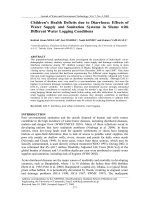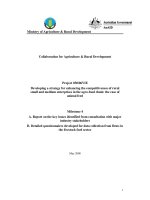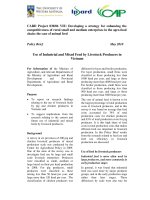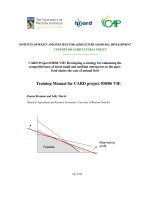Developing the competitive strategy for thien hoa’s supermarket system on a retail market of the electronic and electrical appliances in Hochiminh city
Bạn đang xem bản rút gọn của tài liệu. Xem và tải ngay bản đầy đủ của tài liệu tại đây (2.33 MB, 110 trang )
Capstone Project Report
GaMBA01.C0111 – Group 1
GLOBAL ADVANCED MASTER OF BUSINESS ADMINISTRATION
CAPSTONE PROJECT REPORT
DEVELOPING THE COMPETITIVE
STRATEGY FOR THIEN HOA’S
SUPERMARKET SYSTEM ON A
RETAIL MARKET OF THE
ELECTRONIC AND ELECTRICAL
APPLIANCES IN HOCHIMINH CITY
Group number : 1
Student’s name : PHAM MAI LONG
HUYNH THI BICH LAN
PHAM PHUONG MAI
NGUYEN THANH THAO
HOCHIMINH CITY, JANUARY 2013
Capstone Project Report
GaMBA01.C0111 – Group 1
ACKNOWLEDGEMENTS
F
irstly we would like to thank you see, there are those who have to teach,
impart useful knowledge to us in the past.
T
hanks for the Teachers in the consultancy team and the sisters work in Thien
Hoa comments and create favorable conditions so that we can complete your thesis.
F
inally we would like to express my gratitude to the teacher guide: Dr. Hoang
Lam Tinh dedicated to guide and help us in the process of completing this thesis.
D
ear wishes for good health and work to our teacher and Brothers and Sisters.
Capstone Project Report
GaMBA01.C0111 – Group 1
INDEX
ACKNOWLEDGEMENTS
TABLE OF CONTENTS
LIST OF TABLE IN APPENDIX
LIST OF PICTURES & CHART
PREFACE 1
1. Context, the need and importance of the research topic 1
2. The purpose of research and application capabilities 2
3. Object and scope of the study 2
4. Research methodology: 2
5. Structure of the research topic 2
INTRODUCTION
CHAPTER 1: THEORETICAL BASIS OF STRATEGIC MANAGEMENT AND
COMPETITIVE STRATERGY 3
1.1. Strategic management 3
1.1.1. The concept of strategic management 3
1.1.2. The strategic levels 4
1.1.3. Strategic management process: 4
1.1.4. The role of strategic management: 5
1.2 Competitive Strategy: 5
1.2.1. The concept of competition: 5
1.2.2. The view of competitive strategy 5
1.2.2.1 The period 1950 - 1970 : Ansoft's market development point 5
1.2.2.2 The period 1980 -2000 : Michael Porter‟s views on competition 6
1.2.2.3 The period 2000 to the present: Opinions of W.ChanKim & Renee
Mauborgne for “Blue ocean” strategy 6
1.2.2.4 Competitive characteristics of intergration 7
1.2.3.The types of competition 7
1.2.4. Competitive advantage and the origin of competitive advantage 9
Capstone Project Report
GaMBA01.C0111 – Group 1
1.2.5. Core competencies 10
1.2.6 Value chain 10
1.2.7.Model Michael Porter‟s five competitive pressure 11
1.2.8.Specific competitive strategy point of Michael Porter 11
1.2.8.1. Cost leadership strategy 11
1.2.8.2. Service/product differentiation strategy 11
1.2.8.3. The focus Strategy 11
1.3. Set up the strategy 12
1.3.1. Analysis of the external environment 12
1.3.1.1. Macro environment 12
1.3.1.2. Micro environment 12
1.3.1.3 External factor evaluation matrix 13
1.3.1.4.Competative Picture matrix 13
1.3.2. Analysis of the internal environment 13
1.3.2.1. Internal environment 13
1.3.2.2. Internal factor evaluation matrix 14
1.3.3. Conjoint analysis to strategy: 14
1.3.3.1. SWOT matrix 14
1.3.3.2. The strategic position and action evaluation matrix (SPACE) 14
1.3.4. Quantitative Strategic Planning Matrix (QSPM): 15
1.3.5. Goal setting to implement the strategy 15
CHAPTER 2. REALITY OF COMPETITIVE STRATEGY IN THIEN HOA
SUPERMARKET SYSTEM IN HOCHIMINH CITY 17
2.1. Introduce the company: 17
2.1.1. Company overview 17
2.1.1.1. Overview 17
2.1.1.2. The achievements 18
2.1.2. Vision and mission 18
2.1.2.1. Vision 18
2.2.2.2. Mission 18
Capstone Project Report
GaMBA01.C0111 – Group 1
2.1.3. Business scope: 19
2.1.4. Company‟s culture 19
2.1.5. Chart of company organization: 20
2.1.6. Bussiness situation and the financial ratios of the company: 20
2.1.6.1. Result of the bussiness 21
2.1.6.2. The financial ratios of the company 22
2.2.Evaluate the effect of external environment to business of ThienHoa supermarket
system 24
2.2.1. Macro environment 24
2.2.1.1. Economic environment 24
2.2.1.2. Political and legal environment 29
2.2.1.3. Socio – cultural environment 30
2.2.1.4. Natural environment 31
2.2.1.5. Science and technology environment 33
2.2.2. Micro environment – Evaluation of competitive pressure in the point of
view of M.Porter 34
2.2.2.1 Competitor 34
2.2.2.2 The replacing products and services 41
2.2.2.3. The bargaining power of suppliers 42
2.2.2.4 The bargaining power of customers 42
2.2.3. External Factor evaluation Matrix (EFE) 44
2.2.4. Competitive Picture Matrix (CPM) 46
2.3. Analysis of competitive advantages of ThienHoa electronics : 47
2.3.1. Value chain analysis 47
2.3.1.1. Main activities 47
2.3.1.2 Supporting Activities 54
2.3.1.3 Marginal profit of Thien Hoa 57
2.3.2. Analysis the impact of the factor 58
2.3.3. Internal factor evaluation matrix (IFE) 59
2.4. SWOT matrix analysis: 60
Capstone Project Report
GaMBA01.C0111 – Group 1
CHAPTER 3. BUILDING COMPETITIVE STRATEGY AND SOLUTION TO
IMPLEMENT THE COMPETITIVE STRATEGY 62
3.1. The strategical object of Thien Hoa supermarket system to 2015 and vision to
2020 62
3.1.1. The objective of Thien Hoa supermarket to 2020 62
3.1.2. The specific objectives period 2012 to 2015 62
3.1.2.1. Expanded sales channel system 62
3.1.2.2. Restructure and improve the human resources 63
3.1.2.3. Investment management system with professional application software
63
3.1.2.4. Conducting Equitization company 63
3.1.2.5. Maintain the first position in the 500 largest companies in Viet Nam . 64
3.1.3. The spcific objectives from 2016 to 2020 64
3.1.4 . Competitive objectives of ThienHoa electronic supermarket system 64
3.2. Combined analysis to achieved the feasible strategies 67
3.2.1. Combine 4 factor of SWOT matrix – Strategic Plan 67
3.2.2. Analyse the SPACE Matrix 68
3.3. Decision the competitive strategies 69
3.3.1. Analyse the Quantitative Strategy Planning Matrix (QSPM) 69
3.3.1.1 Group SO 69
3.3.1.2. Group ST: 71
3.3.1.3 Group WT 72
3.3.2. Decision the feasible strategy 72
3.4. Strategic maps for Thien Hoa sellected strategic groups 74
3.5. Solutions, policies to implement the strategy and implementation roadmap 76
3.5.1. Solutions and policies to implement the strategy 76
3.5.2. The route to implement strategies 85
CONCLUSION 88
REFERENCES 90
APPENDICES
Capstone Project Report
GaMBA01.C0111 – Group 1
LIST OF TABLE IN APPENDIX
Table 1.1. Strategic Management process
Table 1.2. Model in competitive pressure in view of Michael Porter
Table 1.3. The external factors evaluation matrix contruction steps (EFE)
Table 1.4. Competitive picture Matrix contruction step (CPM)
Table 1.5. The internal factors evaluation matrix contruction steps (IFE)
Table 1.6. SWOT matrix
Table 1.7. Steps of quantitative strategic planning matrix (QSPM)
Table 2.1. Business situation of Thien Hoa company over the years
Table 3.1. Combined the S-O-W-T in SWOT Mattrix
Table 3.2. Strategic position and action evaluation matrix (SPACE)
Capstone Project Report
GaMBA01.C0111 – Group 1
LIST OF TABLES, FIGURES AND CHARTS
Number of table
Name of table
Page
2.1
The financial ratios of Thien Hoa supermarket system
23
2.2
Gross domestic product of VietNam (GDP)
24
2.3
The external factor evaluation matrix (EFE)
45
2.4
The competitive pictures matrix (CPM)
46
2.5
Point of the main competitors in CPM
47
2.6
The internal factor evaluation matrix (IFE)
59
2.7
SWOT Matrix
60
3.1
Strategic plan for Thien Hoa
67
3.2
Score of criteria in SPACE matrix
68
3.3
Group S-O strategic
69
3.4
Group S-T strategic
71
3.5
Group W-T strategic
72
3.6
The route to implement strategy
86
Number of figure
Name of figure
Page
2.1
Revenue & COGS
21
2.2
Net profit
22
2.3
Diagram of consumer price index to October, 2012
26
2.4
Growth of credit
28
2.5
Compered the competitor in Hochiminh city
40
2.6
Chart of Market estimation 2013 – TV series
43
2.7
Chart of Market estimation 2013 – product family
applications
43
2.8
Chart of Market estimation 2013 – tech product
44
2.9
Chart of advertising and promotion budget of T.Hoa
50
Capstone Project Report
GaMBA01.C0111 – Group 1
2.10
Market share of Thien Hoa supermarket system in
Hochiminh city
52
2.11
Model of Call Center
54
3.1
Speed of develop of Thien Hoa electronics
supermarket system (2002 – 2011)
66
Number of charts
Name of chart
Page
3.1
Strategic map for Thien Hoa strategy of service
differentiation in HCM city
74
3.2
Strategic map for Thien Hoa strategy of
marketshare maintain & stability in HCM city
75
3.3
Strategic map for Thien Hoa strategy of diverse
distribution channels in HCM city
76
Capstone Project Report
Page 1 GaMBA01.C0111 – Group 1
PREFACE
1. Context, the need and importance of the research:
In the context of electronic supermarket chains in Ho Chi Minh City facing the
challenges of the major competitors in the future, the creation of the own
competitive advantages for their satisfactory business and marketing strategies is an
opportunity to the company existance and development. The competition in the
field of the electronic supermarkets are quite sharply during the current tough
economic time, and it will actually be the toughest time of screening the market
competitors and the most important are the direction, way of doing business, market
entry, however, the long-term strategy will decide who goes and who is in. In Ho
Chi Minh City are now 4-5 brands of the electronic supermarket chain with the
well-known names which own the beautiful ground places in a prime location in the
center as Thien Hoa, Nguyen Kim, Cho Lon, Phan Khang, Idea and the market
would be very difficult to have a place for those new enterprises without the
specific strategic orientation with the differentiation and catch in front.
In a past time, the electronic supermarket chains in Ho Chi Minh City are
scrambling to do promotions with a total of a large value on the occasion of New
Year and date of the event. Besides, customers also continued to receive other great
promotions though not for special occasions, can say that the promotion is
becoming "fashionable" continuously applied in order to attract customers, expand
market share. Does not stop attacks promotions that enterprises "killing" each other
mercilessly in the market and the bankruptcy of the supermarket recently, the
electronics supermarkets account for the overwhelming number. For many reasons,
but to see that the "way" continuous dumping to destroy opponents is an important
reason, supermarkets continuous dumping offering low to no profit or even losses to
attract customers. Can be found easily race through price promotions discounts
fierce place and its consequences is the enterprise 'killing" each other, weaken each
Capstone Project Report
Page 2 GaMBA01.C0111 – Group 1
other. For these reasons the above analysis, the project "Developing the
competitive strategy of Thien Hoa supermarkets in the retail market in Ho Chi
Minh City" our group was formed with the desire to help enterprises improvetry
and build their competitive position on the market.
2. The purpose of research and application capabilities:
The competitive situation in the retail market in Ho Chi Minh City.
Determine the status and position of of Thien Hoa supermarkets in the retail
market in Ho Chi Minh City
Analysis of factors affecting the retail market and Thien Hoa competitive
strategy.
Provide solutions to build effective competitive strategy helps Thien Hoa
prestigious and brand in the retail market upon the process of the
international integration.
3. Object and scope of the study:
The activities in the value chain of supermarkets Electric Thien Hoa.
The business rivals in Ho Chi Minh City.
4. Research Methodology: Using practical observation, document research
method, data collection method, data synthesis method and expert method to
implement the project.
5. Structure of the research topic:
Chapter 1: Theoretical basis of strategic management and competitive strategy.
Chapter 2: Reality of competitive strategy in Thien Hoa supermarket system in Ho
Chi Minh city.
Chapter 3: Developing competitive strategy and solution to implement the
competitive strategy.
Capstone Project Report
Page 3 GaMBA01.C0111 – Group 1
CHAPTER 1:
THEORETICAL BASIS OF STRATEGIC MANAGEMENT
AND COMPETITIVE STRATEGY
1.1. Strategic Management:
1.1.1. The concept of strategic management: Strategy is a term derived from the
Greek word "Strategos" used in military. Dao Duy Anh scholars also wrote in the
dictionary to English as follows: "Strategy is the plan in place to win on one or
many fronts". From the 60s of XX century, the strategy applied in the field of
business and introduced the term "Business Strategy". The concept of business
strategy developed over time and they approach it in different ways. In 1962,
Chandler defines: "Strategy is the determination of objectives, basic long-term goals
of the business and the application of a sequence of actions as well as the allocation
of resources necessary to implement thethis objective ". In 1980, Quinn had raised a
more general definition: "Strategy is the pattern or plan to integrate the major
objectives, policies and action sequences into a cohesive overall is rigorously".
Later, Johnson and Scholes define strategy in environmental conditions have
changed rapidly: "Strategy is the direction and scope of an organization in the long
term in order to win the competition by the organization throughthe format of its
resources in a changing environment to meet market needs and meet the
expectations of stakeholders.
Fred R. David defines that the strategic management is "the art and science of
establishing, implementing and evaluating decisions related functionality allows an
organization to achieve these goals". Strategic management is an activity to solve a
set of variables such as leadership, human resources, capital, marketing, production
and operations, research and development, information processing to make
organizations successful planned. Strategic management is a continuous activity,
Capstone Project Report
Page 4 GaMBA01.C0111 – Group 1
establish and maintain the orientation of an organization's business operations,
become the core platform as the basis for the decision-making process timely
response to change, challenges in the business environment.
1.1.2. The strategic level: Strategy is often carried out at three basic levels consist
of the company, business unit and functional part.
Company Strategy: Planning strategy for the whole enterprise based on the
core competencies of the business, includes general orientation of the line
and the scope and scale appropriate in each stage of business activities. There
are 03 types of strategies usually do is Enterprise: Growth Strategy,
reduction strategy and innovation strategy.
Business Unit Strategy (SBU): Focus on strategic planning to improve the
competitive position of products and services in the business based on
existing competitive advantage of enterprises. Strategic business unit focused
on implementation modalities, the main competitors in the market, how to
adapt the enterprise market positioning themselves to gain competitive
advantage. Strategy is often planned in the form of: competitive strategy,
strategic investment strategy and the product life cycle.
Functional Strategy: Planned to focus on the management and use of the
most effective way of resources and enterprises of each unit member; be
developed in order to successfully implement the business unit level strategy
creates competitive advantage for business. The strategic level functions
usually are planned specifically as: Marketing Strategy, production strategies
- operational, strategic management of human resources, strategic R & D,
strategic finance, strategic management systembelieve.
1.1.3. Strategic management process: Typically, a strategic management process
consists of three main stages (Appedix 1.1 - The strategic management process).
Capstone Project Report
Page 5 GaMBA01.C0111 – Group 1
- Phase of the strategic formation: To perform the business task settings,
conduct investigations and studies to determine the limit inside and outside,
decided to long-term objectives and strategic choices instead.
- Phase of the strategic implementation: To implement the actions and it is
considered the most difficult stage in the strategic management process. In
this phase to make up the annual goals, policy making and distribution of the
resources of the business.
- Phase of the strategic assessment: To implement the performance to the
strategic assessment, and quantitative variables to be adjusted timely,
appropriate. This stage usually has three main activities: Review the
elements is the basis for current strategies, measuring performance and
implementing corrective actions.
1.1.4. The role of strategic management: Strategic management has the positive
role business activities of enterprises, help enterprises navigate clear vision, mission
and objectives from which to actively choose a good strategy to increase the
efficiency of operationsbusiness, linking individuals with same goals in business.
1.2. Competitive Strategy:
1.2.1. The concept of competition: Competition is trying to win over, to win for
themselves in a competitive environment with the participation of several actors
together to compete in the market comply with the common bond and can occur at
any time.
1.2.2. The view of competitive strategy:
1.2.2.1. The period of 1950 – 1970 (Ansoft’s viewpoint of market development):
According to this view, an enterprise wants to market development model consists
Capstone Project Report
Page 6 GaMBA01.C0111 – Group 1
of three strategies, namely: market penetration strategies, market expansion strategy
and product development strategy.
Strategy
Purpose
Method
Measures
Market
penetration
Increase
market share
- Increased purchasing power
- Entice customers
- Buy competitors
- Enhanced
Marketing
activities
(advertising
offers, PR,
etc )
- Research and
Development
Market
expansion
Search for new
markets and
customers
- Find new target market
- Find out the value of new
products
Product
Development
Increase Sales
- Development of specific
products
- Development of industry
structure
1.2.2.2. The period of 1980 - 2000 (Michael Porter's viewpoint on competition):
Michael Porter, the witch for the strategy, said that: "Competitive strategy related to
the difference. It is the careful selection of a sequence of different activities to
create a set of unique values". With this view, M.Porter that enterprises can
establish competitive strategy in three ways: low cost, differentiation and strategic
focus. According to him, the nature of the competition is to win market share,
looking for higher returns than the average profit enterprises are.
1.2.2.3. The period from 2000 to the present (Viewpoints of W. ChanKim & Renee
Mauborgne for "Blue-ocean" strategy): Blue-ocean strategy as defined by the two
experts W. ChanKim and Renee Mauborgne (INSEAD - France Institute) does not
create competitive strategies for competition or becomes no longer necessary, not
exploit the existing demand in the market that focuses on the creation and capture
new demand. And "Blue-ocean" is a breakthrough strategy for businesses to explore
their own way, looking for gaps in the market and make the opponent lose potential
competitive. "Blue-ocean" strategy only exists when the enterprise value to create
Capstone Project Report
Page 7 GaMBA01.C0111 – Group 1
customer acceptance and its existence must be measured by the size of the market
power.
1.2.2.4. Competitive characteristics of integration: International integration
activities strengthen cohesion based on shared interests, goals, values, power, and
resources to comply with the regulations, institutions between countries.
International integration has become a major trend and important features of the
current world dachi coordinate all international relations and major changes to the
structure of the world system and national relationships.
International integration helps economic growth, improve competitiveness and
attract investment, to acquire new technology, international market access,
opportunity to enjoy products and services at competitive prices, enhance
reputationcredit and international position, maintain stability for sustainable
development. However, besides the positive side, there are certain limitations when
integrated, there is increasing competition leads to difficulties for enterprises even
bankruptcy consequences for the economy; increased dependence on the volatility
of the international market; risk of natural resource depletion and environmental
degradation.
Competitive integration forces all countries to accept the "rules of the game" free
competition, ie market opening, loading and unloading of tariff and non-tariff
barriers to foreign goods and services,remove investment restrictions. In terms of
economic development at a low level, free competition put the country before the
enormous challenges. Competition, the enterprise integration will be increased
competitive pressure of imports and foreign suppliers on the domestic market, while
imports diversified quality and low pricemore, the supplier has experience in
international competition.
1.2.3. The types of competition:
Capstone Project Report
Page 8 GaMBA01.C0111 – Group 1
* Competition between the participants in the market:
- Between buyers and sellers: Sellers want to get the highest price and the
buyers wants to buy the lowest price and the agreed price is a result of the
negotiations from the two sides.
- Among those who sell to each other: Competition to grab the customers and
the marketshare, It is result that the price drops down for a benefit of the
buyer. In the competition, any enterprise does not withstand the pressure of
the market so it will have to withdraw from the market and cedes
marketshare to the stronger competitors.
* Competition within the scope of the economic industry:
- Competition inside the industry: Competition between enterprises in the
same industry with the production of the same good and service. The result
of this competition is to make the development of the technology and better
good or service to the customers.
- Competition between the industries: Competition between enterprises in all
economic sectors together to obtain the highest profit.
* Base on the nature of the competition:
- Perfect competition: Competition among many sellers in the market in which
there is not any control of the price in the market. Products sold are similar in
specifications, quality and designs. And to win the competition, enterprises
need to find the ways to reduce costs, lower costs or differentiation of the
product/service to the competitors.
- Imperfect competition: Competition among sellers of the heterogeneous
products to get the advantages in the competition by using the supported
tools such as advertising, promotion, service, preferential price
- Exclusive competition: The market only one or few sell a product or service
that the price should be decided by the sellers not to depend on the supply-
demand law.
* Base on the tricks to the competition:
Capstone Project Report
Page 9 GaMBA01.C0111 – Group 1
- Fair competition: Competition in accordance with the relevant laws and with
the social recognition, it usually takes place fairly and openly.
- Unfair Competition: Competition based on the legal loop-holes, contrary to
social norms and condemned by society.
1.2.4. Competitive advantage and the origin of competitive advantage:
Competitive advantage is possessed of unique values, can be used to "seize the
opportunity" to profit. When it comes to competitive advantage, we discuss the
advantages that a business is there and can be compared to their competitors.
Basically, the competitive advantage derived from the values that can generate
business for the buyer, this value must be greater than the costs now spent.
Competitive advantage is a concept for now, there is micro, not macro-taking at the
national level. Also appearing term sustainable competitive advantage means that
enterprises must continuously provide the market a special value that no other
competitor can offer.
The basic factor is the source to create competitive advantage is the value chain
include: efficiency, quality, innovation and customer response. These values make
up two basis points to create competitiveness for business: Low cost and the
differentiation.
- Efficiency: Target performance is often measured by output per worker and a
company as efficient as it needs fewer inputs to produce a given output.
- Quality: The high-quality products will reduce labor time for higher labor
productivity and lower unit costs.
- Improvements: Improvements in the way in which a company operates or the
development of products.
- Meet customers: identify and satisfy customer needs better than the
competition. So customers will feel the product value of the enterprise, and
the enterprise competitive advantage based on the differentiation.
Capstone Project Report
Page 10 GaMBA01.C0111 – Group 1
1.2.5. Core competencies:
Core competencies of a business is the possibility that businesses can do well, but
must simultaneously satisfy three conditions, including: ability to bring benefits to
customers that competitors difficult to imitate and that capacity must be able to
expand to other markets and products. Core competencies could be technology,
technical know-how, close relationships with customers, distribution system, strong
brand. Core capabilities to create competitive advantage for enterprises in the
production and trading. When developing products, services, businesses often rely
on core competencies, its existing strengths. This is considered a top priority for
many businesses when considering the decision to develop products and services
complement of products and services available. Core competencies will create a
competitive business advantage, greatly reducing the risk of goal setting and
strategic planning, help determine the success or failure of the project.
1.2.6. Value Chain:
Integrated value chain related activities of the enterprise in order to create and add
value for enterprise customers, including activities from research and development,
design, production and operation,distributors and service providers in order to
increase the value of tangible and intangible assets to customers. Is an effective tool
to identify, build competitive advantage in strategic planning to create greater
customer value chain for the cost of doing business for production and business
activities of enterprises increase efficiency. When analyzing the value chain,
enterprises will identify the internal capacity of the organization through accurate
identification of strengths and weaknesses in the current operation; determining
competitive advantage, implementing effective strategies, increase the value of the
beneficiary customer, strategic decision to increase the overall performance.
Capstone Project Report
Page 11 GaMBA01.C0111 – Group 1
1.2.7. Model of the five competitive pressures as Michael Porter's viewpoint:
Model of the five competitive pressures is a tool to analyze the power of the market
pressure from factors that can neutralize the pressure using appropriate strategies to
minimize business risks, improvethe company's competitiveness in the market.
Analysis of model five competitive pressures will help businesses decide the
particular strategy (Appendix 1.2 - Model of the five competitive pressures as
viewpoint of M. Porter).
1.2.8. Specific competitive strategy as Michael Porter's viewpoint:
1.2.8.1. Cost leadership strategy: This strategy is understood as maintaining the
lowest cost in the industry or in the market. Want to pursue this strategy requires
capital investment in technology, operational processes with high efficiency, low-
cost platform (labor, materials, equipment, etc.) to help reduce costs. Greatest risk
when applying this strategy is not only our business have access to cheap resources.
So, other competitors can fully copy of the business strategy. The important thing is
whether the business has the ability to maintain a lower cost competitors during
production or business activities.
1.2.8.2. Service/Product differentiation strategy: Core content of this strategy is to
make the products / services of different enterprises and more attractive products /
services of competitors (in form, features, reliability, quality of service, brand
image, etc.). For the successful application of this strategy, enterprises need process
research and development (R & D) and innovation good product; ability to provide
product / service quality; marketing and saleseffectively to ensure that customers
can feel the difference and the benefits that it brings. Now apply this strategy to be
very quick in the new product development process. If not, the business will
dominate the loss of market share by more successful competitors use this strategy.
Capstone Project Report
Page 12 GaMBA01.C0111 – Group 1
1.2.8.3. The focused Strategy: Pursue business strategies focused on the niche
market, it is the small market segments with distinct characteristics. Competitive
advantage of these firms were created based on a deep understanding of the
characteristics of the market and ability to provide the product/service in accordance
with these characteristics. However, the focus of the market on a small suite of
enterprise resources is not necessarily safe, because large enterprises with better
resources can still attack on the segment. The risk that the business application
focus strategy often must continue to create other advantages (cost reduction or
differentiation of products /services), to bring more added value to customers in its
segment. Therefore, the focus strategy is also divided into two strategic: Strategy
focused on low-cost platform and focused strategy based on differentiation and
selection strategy is dependent on the capacity as well as the strengths of the
business.
1.3. Building of the competitive strategy:
1.3.1. Analysis of the external environment:
1.3.1.1. Macro environment: Analysis of the macro environment is the overall
environmental analysis to identify the opportunities or risks affecting the business
activities of the enterprise. Analysis of the macro environment is to evaluate the
external factors indirectly impact the ability to create and profit targets of the
business planning. There are five external factors have a major impact on business:
Economic factors, politic factors, social factors; technology factors, natural factors.
1.3.1.2. Micro environment: Micro environment analysis is to analyze the
competitive environment to identify the opportunities or risks that affect business
activities of the enterprise. Micro environment analysis to assess the external factors
impact directly on the ability to create and profit targets of the business planning.
To evaluate the effectiveness of the micro environment, the strategy is often used in
Capstone Project Report
Page 13 GaMBA01.C0111 – Group 1
the model of the five competitive pressures as Michael Porter‟s viewpoint to
analyze.
1.3.1.3. External factor evaluation matrix: External Factor Evaluation Matrix – EFE
Matrix enables integrated management strategies and evaluate key opportunities and
threats of the external environment affect the organization of information on the
economic, social, cultural, demographic, geographic,political, legal, technological
and competitive. EFE matrix is developed in five steps (Appendix 1.3 - The EFE
matrix construction steps).
1.3.1.4. Competative Picture Matrix – CPM: Competative Picture Matrix – CPM
used to identify the major competitors in the market and compare the advantages
and limitations between these competitors possesses the market. Competative
Picture Matrix is the expansion of the EFE matrix. Competative Picture Matrix help
administrators identify strategies to be the main competitor with the level of
importance, and classification of critical points in order to compare and analyze the
same level of significance to realize the advantagestheir competition and weak
points to overcome. Total score, the classification level of the company's key
competitors after the evaluation are compared with the organization in order to
analyze the external environment looking for the key strategic information
(Appendix 1.4 - Steps to build the CPM matrix).
1.3.2. Analysis of the internal environment:
1.3.2.1. Internal environment: Internal environmental analysis is to identify the
available resources and potential, strengths and weaknesses internal to the
organization now and in the future as a basis for the formulation of overall
objectives of the strategy becomesimplementation and the means to implement the
strategy effectively. When strategic planning, internal environmental factors are
often interested in analyzing mainly composed: Human resources of the
Capstone Project Report
Page 14 GaMBA01.C0111 – Group 1
organization, ability to research and development, scale of production operations,
financial capability, business accounting, perform marketing degree, culture of the
organization
1.3.2.2. Internal Factor Evaluation Matrix - IFE Matrix: Internal Factor Evaluation
Matrix – IFE Matrix is synthesis tools and evaluate the strengths and weaknesses of
important parts business functions within the organization, and it is also the basis
for identifying and assessing the mutual relationship between the parts actually
function effectively bringing high-performance work in collaboration resolve. IFE
Matrix is also developed in five steps (Appendix 1.5 - The IFE matrix construction
steps).
1.3.3. Conjoint analysis to build the competitive strategy:
1.3.3.1. SWOT Matrix (Strength – Weakness – Opportunity – Thread): The fact that
every business should not pursuing multiple strategies simultaneously, because each
strategy requires a very different approach. First, we need to use SWOT analysis
model to analyze the strengths, weaknesses, opportunities and threads of the
business when applied to each type of the above strategies, to understand the
strategy most likely to succeed. At the same time, the need to combine this result
with the analysis of the competitiveness in the industry or in the market. SWOT
Matrix is an important tool combined help administrators on the basis of the
organization's resources strategic planning groups including arc combination of four
factors S – W – O – T: Strength - Opportunity (SO), Weakness - Opportunity (WO),
Strength - Thread (ST), and Weakness - Thread (WT). SWOT matrix model
(Appendix 1.6 - SWOT Matrix).
1.3.3.2. The strategic positioning matrix and evaluation activities - SPACE Matrix:
The strategic positioning matrix and evaluation activities is a strategic planning tool
during the combination of strategic analysis framework formed. SPACE Matrix was
Capstone Project Report
Page 15 GaMBA01.C0111 – Group 1
described as a two-dimensional coordinate axis four-quadrant framework for the
choice of location is prudent strategy, attack, defense or competition. The
organization's overall strategic position is determined based on the evaluation of
activities by the most important determinants, consists of two elements within the
enterprise on the coordinate axis as the financial strength (FS), competitive
advantage (CA) combine of two external factors of the business on the coordinate
axis as industry strength (IS), environment stability (ES).
1.3.4. Quantitative Strategic Planning Matrix - QSPM:
Quantitative Strategic Planning Matrix is the only tool that allows strategic
management decisions relative attractiveness and objective selection strategy can
choose. QSPM matrix is the third phase of the analytical framework for strategic
planning, which uses the inputs by the analysis in the first stage and the combined
results of the analysis in the second stage to determine the strategic objective of the
likely alternative. The attractiveness of the various strategies identified in matrix
QSPM by leverage or improve key elements of the external environment and inside
the enterprise. The number of strategies comparison in matrix SQPM is not limited
and can use many matrix to compare the strategic group, but only in a certain group
strategy can be evaluated together. Building process of QSPM matrix is described in
six steps (Appendix 1.7 - construction steps of QSPM matrix).
1.3.5. Goal setting to implement the strategy:
The implementation of the strategy affects the entire company, a strong impact on
all functional business areas and unit parts of the company. The implementation
strategy is linked closely with the stage of setting strategy but if the strategy sets the
position of a force resource before an action, emphasis on financial performance.
Capstone Project Report
Page 16 GaMBA01.C0111 – Group 1
The process requires the knowledge of the analytical skills and intuition and needs
the cooperation among groups under the leadership of the high-level management.
The transition from stage of setting the strategy into stage to implement the strategy
should have the participation of the functional administrators and related parts as
much as possible both of the two stages of the strategy.
Establishing annual goals are very necessary to implement the strategy because it is
the basis for the distribution of the force resources, the evaluation mechanism for
the administrators, it is a tool to control the evolution of the long-term goals and set
the priorities for the company, units and departments. The annual goals are
published in the form of the ability to make a profit, growth and marketshare of
each business unit, geographic region, customer groups and disseminate products.
The annual goals should be measurable, reasonable, clearable, challenging and it
should be determined in an appropriate period of the time with a worthy
encouragement. In addition, For the effective implementation of the strategy, it is
also required a policy for the control system and cooperation between the unit parts
to make it easier to solve the problems and achieve the goals.









